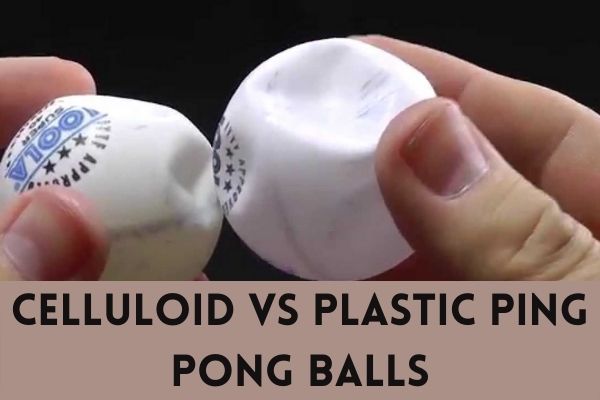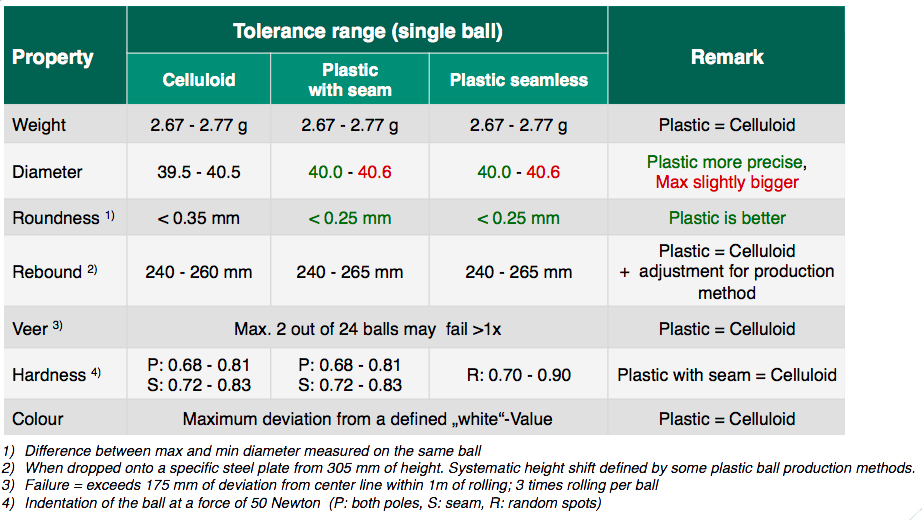Celluloid vs Plastic Ping Pong Balls have been around since the 1880s and come in a variety of materials. Celluloid ping pong balls were popular until plastic became more cost-effective. Ping pongs made from celluloid are still available, but they are difficult to find because many players prefer plastic for its durability. Plastic is also less expensive than celluloid balls, which makes it easier for new players to purchase them without breaking their budget. But what does this mean for your game? Read on to find out.

Contents
Which is better, Celluloid vs Plastic Ping Pong Balls?
Plastic Ping Pong Balls

Plastic is better than celluloid for a number of reasons. First, plastic is more durable
and holds up well against drops and slamming. Second, they have a uniform bounce that most players prefer over the varying bounces produced by celluloid balls. A uniform bounce means that they will all travel at the same speed and distance, which makes for a more enjoyable game. Plastic balls also last longer than celluloid balls. Celluloid is easily scratched and nicked, which affects its playability. If you keep playing with damaged balls they will eventually need to be replaced.
Celluloid Ping Pong Ball
For many years, table tennis has been played with celluloid ping pong balls. Nowadays, however, the wonder material of the 21 st century is beginning to replace this old-fashioned ball.

The introduction of polyester balls made from high-tech materials represents a quantum leap in technology within the sport. The new ball floats on water and feels more like rubber than plastic. “It’s fantastic . That’s all I can say,” enthuses Timo Boll , German national coach and multiple European champions.
Despite its chemical structure celluloid is actually an artificial polymer that does not consist of any natural components. It is made up entirely of carbon-based synthetic molecules linked together chemically to form long chains similar to those used for making plastics like polyethylene and polypropylene.
Also check: Why can a Dented Ping Pong Ball Repaired by Heating?
Celluloids are created by dissolving cellulose in some solvent, which is then evaporated to leave the required solid polymer film. The early manufacturing process of nitrocellulose (guncotton) was dangerous due to the extremely flammable content of the vapour produced. This dangerous method made this plastic very popular at early 20th century carnivals where it was used for everything from magic tricks to creating pretend ghostly apparitions or fake fireworks displays.

As far as cost goes, plastic is less expensive than celluloid. It is possible to find wooden paddles that are reasonably priced, but celluloid balls will always be more expensive than plastic ones. With all these benefits, there is no reason why you should be using celluloid balls when you can easily switch to plastic.
What are the benefits and drawbacks of each type of ball?

Plastic balls are more durable than celluloid ones, which makes them the better choice for intense games. They also offer a truer bounce because they are made with high-density plastic. The drawback of this is that players must learn how to compensate for the speed and spin of the ball compared to celluloid balls.
Only companies and people with companies can purchase the new type of balls. If you are not a business, your only option is to use top-quality rubber playground balls.
These have fewer benefits than the new ball, but they are the best option for people who do not want to buy from a company. Rubber playground balls are less expensive than turf or indoor balls, but one of their biggest advantages is that they are easily replaced if something goes wrong. These are often sold in bulk packs of three hundred due to their cheap nature. They still last long enough to be worth purchasing at this price, usually lasting between ten and fifteen years before needing replacements due to wear or damage.
Tennis balls made with natural wool felt will start to fray after just seventy hours or so of use. While this does not affect their longevity in practice (most balls last well beyond none when it comes to sports balls. However, yellow has two years) it means that they cost slightly more than synthetic brands due to waste and replacement.
As for the difference between yellow and white, there is no difference. Like most sports balls, these two balls are designed to have the same weight distribution and bounce height so that they have similar flight patterns.
The biggest advantage of synthetic balls is their durability. While natural felt tennis balls can hold up for several hours of regular play under normal weather conditions, they will last for months if used on courts with good surfaces. Being able to use the ball, again and again, means that there is no need to buy new ones frequently, which saves money in the long run while also cutting down on waste while keeping landfill costs low at the same time.
Celluloid balls are made with a more durable resin, which makes them better suited to ping pong players who are just learning how to play. They also have a faster rebound time because they bounce back faster. The downside of celluloid is that it can break easier than plastic, causing dangerous shards on the table and bouncing surfaces.
How do they differ in price?

The simple “answer” is one dollar – but if you want to know exactly how many cents are in that price, read on.
To make it easier for our calculations, let us say that the standard 40mm (~1.5 inch) ping pong balls you find at any store are among the cheapest ones available – they usually range from 0.55$ to 1$. And because any object’s price can be discounted based on several factors (quantity purchased, sales etc.), we’ll take into account three different situations: buying 16 pieces (~3$), buying 100 pieces (~20$), and buying 1000 pieces (~200$). This way, we’ll be able to see the price difference based on how many balls are purchased.
The calculations are shown below, but if you have good maths skills, you might want to skip them and go straight to the conclusion.
16 ping pong balls (~3$): 16 * 0.55 = 8.8$
100 ping pong balls (~20$): 100 * 0.55 = 55$
1000 ping pong balls (~200$): 1000 * 0.55 = 550$
As you can see, buying 1000 pieces costs ~2 times less than buying 100 pieces , which in turn is ~4 times more expensive than buying 16 . Interestingly enough, because the amount of money saved increases exponentially with quantity purchases.
Plastic balls are cheaper, but the high-density celluloid balls travel at a better bounciness and speed. The best balls are produced in a factory because they make the final product more consistent between each ball. Plastic balls become warped when left out in high heat, while celluloid ping pong balls can be used in all weather conditions. The celluloid ball is more expensive than the plastic one, but it holds up during gameplay better. Plus, celluloid balls are easier to see than their plastic counterparts.
Celluloid ping pong balls also have a higher bounce height than most plastic models, which has led many tournaments to switch to them. Plastic makes the ball lighter and cheaper, but it also makes the ball not see as well during night play. Celluloid balls are often painted, which helps them hold up better over time. Plastic balls sometimes have a reflective coating that helps users see them more easily when they’re in low light conditions.
Check more: Are Ping Pong and Table Tennis The Same Thing?
Why does one break more than the other?
Celluloid balls tend to break more often than plastic, which can be a problem for tournaments. In fact, the International Table Tennis Federation has banned them from official competition because they’re too likely to break and cause a dangerous situation. Celluloid balls have been known to shatter into large shards that fly all over the room when they hit something or someone. While modern plastic ping pong balls are significantly tougher, they aren’t as tough as celluloid. They also tend to be bouncier than their celluloid counterparts, increasing the chances that a failed shot will bounce out of the way instead of hitting somebody or something else in the room.
Conclusion
When it comes to choosing ping pong balls for your table tennis set, the choice is usually between celluloid or plastic. These two types of balls differ in cost and durability. Celluloid balls are typically more expensive than their plastic counterparts but they last much longer when played with frequently. Plastic balls break easier than celluloid because they can’t take as many hits without breaking apart which may be an issue if you plan on playing competitively or often at home with friends and family members. If you want a cheap alternative that will still get the job done then go for plastic!

